At seventy-five miles an hour, it only takes fifteen minutes for hearing to be damaged by the sound of the wind blowing past your head – even when wearing a helmet.
This damage is permanent. Close to half of Grand Prix riders have hearing loss, and 68% of young riders now wear ear protection. Still, close to one-fifth of riders are unaware of the permanent damage they are doing to their hearing. Not only do we need to change this behavior, but we also need to know the best options to do so without making life difficult.
To protect from hearing loss, earplugs are not only a good idea, but they are as essential as a helmet or leathers. Fortunately, modern technology has provided a range of suitable plugs for riders that can be comfortable, great at preventing hearing loss, and not cost a fortune. By having a basic understanding of what makes a good earplug, you can save money, protect your hearing, and not feel like you’ve got a couple of bananas jammed up in your ears.
- Factors to Consider in Motorcycle Earplugs
- Top 10 Best Motorcycle Earplugs 2025
- 1. Best Overall Motorcycle Earplugs: Vibes High Fidelity Earplugs
- 2. Best Premium Motorcycle Earplugs: EAROS ONE High Fidelity Acoustic Filters
- 3. Best Ceramic Motorcycle Earplugs: NoNoise for Motorsport's Ear Protection
- 4. Best App-Enabled Motorcycle Earplugs: EarDial HiFi Earplugs
- 5. Best Budget Motorcycle Earplugs: Plugfones Basic Earplug-Earbud Hybrid
- 6. Best Hypoallergenic Motorcycle Earplugs: Alpine MotoSafe Race Reusable Ear Plugs
- 7. Most Comfortable Motorcycle Earplugs: Decibullz Custom Molded Earplugs
- 8. Least Visible Motorcycle Earplugs: ClearPlugs High Fidelity Invisible Ear Plugs
- 9. Most Customisable Motorcycle Earplugs: EarPeace Motorcycle Ear Plugs
- 10. Best Disposable Motorcycle Earplugs: Mpow Super Soft Sleeping Earplugs
- Guide to Buying the Best Motorcycle Earplugs for 2025
- A Crash Course in Sound and Hearing
- How Much Sound Does Riding a Motorcycle Make?
- What Causes Hearing Loss?
- How Do Earplugs Work?
- What Is the Noise Reduction Rating?
- The Secret Additional Benefit of Reducing Wind Noise
- Common Motorcycle Earplug Materials
- What About Music?
- The Problem With Noise Cancelling Technology
- Earplugs and the Law
- Final Thoughts
Factors to Consider in Motorcycle Earplugs
We only need to keep in mind a few key factors to find good motorcycle earplugs. We need to know the different types, what they’re made from, how well they block noise, how comfortable they are to wear, and how much they will cost us.
Once we know how a set of earplugs fills these needs, we can decide if they are right for us.
Types
There are three main types of motorcycle earplugs available. Each has its pros and cons, which are explored further in our product review section. For now, it’s enough to know the basic forms you can expect to come across.
- One-size-fits all: Generic sizing, but reusable
- Custom molds: Mold to fit your unique ear shape with repeated use
- Disposable: Generic sizing, only intended for limited use
Sound Dampening
Understanding how sound works is a complex matter, and we do discuss the basics in our full buyer’s guide. The important number to know is the Noise Reduction Rating (or NRR). This gives us an idea of how well our plugs remove the higher range of sounds. Some overseas brands prefer using the European Union’s Single Number Rating, or SNR, which has a different set of numbers. We have done our best to use NRR when we can.
An NRR of 10 or above will ensure that the most dangerous levels of sound from riding at high speed are removed, while earplugs with an NRR of 25 or more may also be useful for even louder activities such as shooting. However, earplugs with these higher numbers do not offer you extra riding time, as both earplugs are likely to decrease the loudness down to a similar level. Earplugs that do offer longer riding time are also those that block out noises from conversation.
Notably, active noise-canceling devices will not prevent hearing loss and are not alternatives to earplugs. You can read more about the problem with noise-canceling technology in our complete buyer guide.
Filtering
It’s good for the sound to be dampened, but it is even better when we don’t lose sounds at a lower decibel, like music in our helmet or conversations going on around us. The best earplugs use filtering technology to allow this to happen, without being ineffective at blocking the sounds that cause hearing loss.
Material
Besides the obvious need for some of us to avoid latex, there are a couple of useful things to know about how materials can be useful in creating good earplugs. Silicone-based earplugs get dirtier but are less likely to slip out of your ears.
Thermoplastics are easier to mold into smaller ear canals, while some earplugs are made of patented technologies. For further insight into earplug material, you can check out our full section below.
Lifespan and Cost
You can get foam earplugs for cents, and we have found the best value with the Mpow earplugs, but these plugs will only last a few trips at best, being wasteful. Spending a few dollars on a high-quality brand can give you a pair that will last you years, and only need cleaning with some soapy water.
If you choose one of these, of course, you want a good storage system. Luckily, a number of our products come with great little cases to keep on you at all times.
Comfort
While the material of earplugs plays a major role in comfort, many other factors come in. Because human ear canals come in all sorts of widths and lengths, the size of the earplug can be very important. Sets that include different sizes are more likely to provide long-term comfort. Some motorcycle earplugs, like the Decibullz Custom Molded Earplugs, let you custom mold to your ear, making them the most comfortable option for extended trips.
Another factor in terms of comfort involves how easy it is to insert and remove plugs from your ears. Some earplugs are notoriously hard to remove without the help of a pair of tweezers. Cheap foam earplugs need shaping to fit properly. The easier an earplug is to insert and remove, the less likely they will slip out and the more likely they will create an effective seal for proper sound dampening.
| Product | Noise Reduction Rating | Size | Material | Comes with | Rating |
|---|---|---|---|---|---|
| Vibes High Fidelity Earplugs | 15 | Tips of S, M, and L sizes. | Made from Thermoplastics. | Earplugs with three sets of tips, case, user guide. | 5 |
| EAROS ONE High Fidelity Acoustic Filters | 17 | Multiple tips to suit the ear canals of different sizes. | Made from ABS plastic and TPE. | Earplugs, two pairs of tips (small and large), carry pouch. | 5 |
| NoNoise for Motorsport's Ear Protection | Unknown (SNR 21) | One size fits all. | Made from thermoplastics and ceramics. | Earbuds, aluminum case. | 4.5 |
| EarDial HiFi Earplugs | 11 | One size fits all. | Made from clear silicone | Comes with: Earplugs, aluminum container, luminescent sticker, and link to mobile applications. | 4.5 |
| Plugfones Basic Earplug-Earbud Hybrid | 26dB | One size fits all. | Made from Silicone. | Earbuds, pair of earplug tips | 4.5 |
| Alpine MotoSafe Race Reusable Ear Plugs | 17dB | One size fits all. | Made from patented material. | Earbuds, pouch, tool, user guide. | 4 |
| Decibullz Custom Molded Earplugs | 31dB | Molded fit, with tips of S, M, and L sizes and M foam alternative. | Made from Thermoplastics. | Moldable earpieces, sound plug, four sets of tips, carry case. | 4 |
| ClearPlugs High Fidelity Invisible Ear Plugs | Unknown (25 SNR). | Small and large size. | Made from Silicone. | Earplugs in two sizes, aluminum case. | 4 |
| EarPeace Motorcycle Ear Plugs | 11-19. | Small and large size. | Made from Silicone. | Earplugs in two sizes, aluminum case. | 3.5 |
| Mpow Super Soft Sleeping Earplugs | 32dB | One size fits all. | Made from Polyurethane foam. | 60 Earplugs, an aluminum case that holds one pair. | 3.5 |
Top 10 Best Motorcycle Earplugs 2025
1. Best Overall Motorcycle Earplugs: Vibes High Fidelity Earplugs
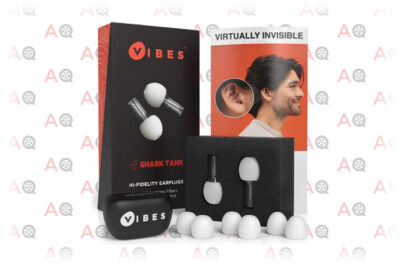
Editor’s Rating:
Quick Facts:
- Noise Reduction Rating: 15
- Tips of S, M, and L sizes.
- Made from Thermoplastics.
- Comes with: Earplugs with three sets of tips, case, user guide.
It is understandable to be skeptical about any product that markets itself as “as seen on television.” So when we saw that the Vibes High Fidelity Earplugs had their start on the show “The Shark Tank,” we came at them from a place of caution. We didn’t need to worry.
The Vibes earplugs do a wonderful job of filtering out only the most dangerous wind noise while maintaining the ability to hear the world around us. Low-profile earplugs, you can only tell you are wearing them from a small stalk, which makes them easier to insert and remove.
Talking about insertions, the Vibes come with three different sizes of tips and are made from thermoplastics that make them quite comfortable and provide an adequate seal. When inserted correctly, they are not prone to slipping out or being pushed too far in.
Our only concern about these is the dampening. At the lower end of NRR we would recommend, the Vibes are not suited for riders on the race-track or hitting an unlimited highway. For the standard road user, however, these are a perfect choice. A reasonable price for a comfortable, high-quality pair of earplugs that don’t make you feel awkward keeping them in all day.
Pros
- Comfortable tips with three different sizes.
- Clear ability to hear conversations and music.
- Low profile look while still being easy to remove.
- Great value for money.
Cons
- Not as useful at higher speeds.

Editor’s Rating:
Quick Facts:
- Noise Reduction Rating: 17
- Multiple tips to suit the ear canals of different sizes.
- Made from ABS plastic and TPE.
- Comes with: Earplugs, two pairs of tips (small and large), carry pouch.
The technology behind the EAROS ONE earplugs is outstanding. Designed by the former Director of MIT’s Acoustics & Vibrations Lab, they are made from medical-grade plastics in a facility just outside of New York. Their patented filtering core is second-to-none at ensuring a clear sound when talking, or listening to music, while removing the louder noises that cause hearing loss.
Of course, this alone would not be enough to qualify for the best motorcycle earplugs. These are also one of the more comfortable earplugs available, especially as the tips come in two separate sizes. They do not impact the air-pressure felt (no popping!) and the thermoplastic polymer (TPE) they are made from does not cause itchiness or sweating. You can easily wear these for over 6 hours without feeling discomfort.
The EAROS ONE earplugs do come with an app but, unlike the EarDial earplugs, only for iPhone. They are also one of the more high-profile earplugs, easy to see (but not sticking out from your head). They come with a storage pouch that isn’t as protective as some of the aluminum cases available but the plugs themselves are sturdy enough that this is not an issue.
The EAROS ONE earplugs are expensive, nearly twice as much as the Vibes. In our opinion, they are worth the extra investment if you can afford it.
Pros
- Designed by MIT experts.
- Made from medical-grade TPE instead of Silicone, for extra comfort.
- Two sizes for tips.
- Made in the USA.
Cons
- Pouch not the safest storage from damage.
- High-Profile look.
3. Best Ceramic Motorcycle Earplugs: NoNoise for Motorsport's Ear Protection
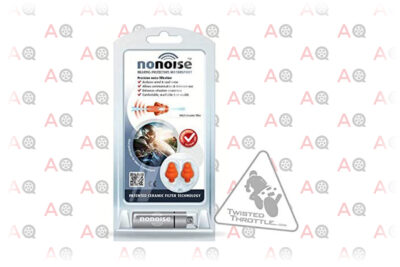
Editor’s Rating:
Quick Facts:
- Noise Reduction Rating: Unknown (SNR 21)
- One size fits all.
- Made from thermoplastics and ceramics.
- Comes with: Earbuds, aluminum case.
If you are the motorcyclist looking for quality earbuds that can handle higher speeds, then we highly recommend the NoNoise for Motorsports. NoNoise has a range of earplugs for every context, each designed specifically with that purpose in mind. Knowing this, they aim for a specific level of attenuation, which they reach using a ceramic core that lasts longer than other earplugs. In this case, the magic number is an SNR of 21, which offers as high as 29dB of difference.
While most of the quality earplugs can survive for close to a year, the workmanship and sturdy materials make for a pair of earplugs that will still do the job three years later. This greatly makes up for the higher price point. To ensure they last, the pack also comes with a nifty aluminum case for safe-keeping when not in your ears.
A low-profile pair, these can be a little difficult to remove from larger ear-canals and unfortunately only come as “one size fits all.” If you are already aware of a fit problem with other earplugs, it might be better to look at the Vibes instead.
For long-lasting earplugs that can handle the louder noises of high-speed racing, the NoNoise for Motorsports is highly recommended.
Pros
- Ceramic core allows for greater attenuation of higher decibels.
- Longer-lasting than most earplugs.
- Nifty aluminum case.
Cons
- Difficult to remove.
- One size fits all.
4. Best App-Enabled Motorcycle Earplugs: EarDial HiFi Earplugs
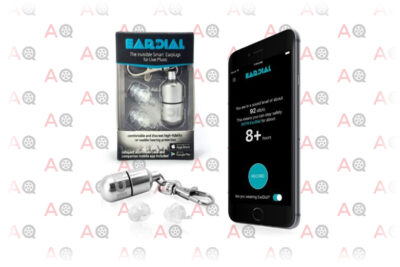
Editor’s Rating:
Quick Facts:
- Noise Reduction Rating: 11
- One size fits all.
- Made from clear silicone
- Comes with: Earplugs, aluminum container, luminescent sticker, and link to mobile applications.
Being the first set of earplugs to come with mobile applications for both iPhone and Android, the highly-marketed EarDial Earplugs can be an appealing choice for the computer-minded. The applications register the sound around you and let you know how long you can safely travel both with and without the earplugs. Knowing just how effective these are is pretty impressive.
A low NRR means these are not great for racing but are surprisingly still quite effective at high speeds on the road. This may be due to the snug fit, sitting slightly deeper into the ear canal than others.
While this size may mean larger-eared users may find them slipping out, or hard to remove, most people find them comfortable and secure. Made of clear silicone, these are very low-profile, and most people won’t even know you are wearing them.
The earplugs come with an aluminum container with a cool luminescent sticker to help you easily find them in a dark jacket pocket or bag. It’s a good thing since they don’t take up much space at all. You could even keep them on your keyring.
It should be mentioned that if you do face a problem (from discovering the size is a problem or the odd broken container), the customer service for EarDial is beyond par. Some customers even find themselves talking to the CEO directly.
For low-profile earplugs and a nifty mobile application, the EarDial Earplugs are worth considering.
Pros
- Low-profile design.
- Keyring carry case with a glow-in-the-dark sticker.
- Easy-to-use mobile application.
- Great customer service.
Cons
- Don’t always fit comfortably.
- Some cases have broken.
- Made from silicone.
5. Best Budget Motorcycle Earplugs: Plugfones Basic Earplug-Earbud Hybrid

Editor’s Rating:
Quick Facts:
- Noise Reduction Rating: 26dB
- One size fits all.
- Made from Silicone.
- Comes with: Earbuds, pair of earplug tips
Without a doubt, you are making a compromise when you buy the Plugfones hybrid. The earplugs are effective at blocking noise, indiscriminately removing all loud sounds, while also removing any ability to have a conversation while they are in.
That’s okay, of course, because these are not designed for conversation. These are for music. And while the earbud doesn’t provide as beautiful a sound as you might get from a good pair of Bose earphones, they do let you listen to good-quality music while still protecting yourself from hearing loss.
The earbuds are well-protected from damage and it is difficult to damage any of the connections. For a premium, you can purchase a pair that includes active noise-canceling, with BlueTooth and a noise-isolating mic that works quite well for taking hands-free phone calls.
A decent pair of earbuds and a noise-killing pair of earplugs in one, the Plugfones hybrid is a compromise well worth making.
Pros
- Can listen to music while blocking out the damaging noise.
- Tough material makes them hard to break.
- Multiple options including premium BlueTooth and easy-access control.
Cons
- They have cords.
- Indiscriminate sound-blocking.
6. Best Hypoallergenic Motorcycle Earplugs: Alpine MotoSafe Race Reusable Ear Plugs
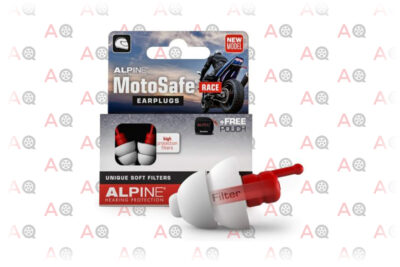
Editor’s Rating:
Quick Facts:
- Noise Reduction Rating: 17dB
- One size fits all.
- Made from patented material.
- Comes with: Earbuds, pouch, tool, user guide.
To get a designed-for-riding pair of earplugs that are made from latex-free, silicone-free material that is sturdy and effective in its sound-dampening, is not something you would expect for under twenty-five dollars. However, that is exactly what Alpine offers with its MotoSafe Race Reusable Ear Plugs.
With a respectable NRR and made with a patented AlpineThermoShape recipe that is both comfortable and safe for all skin types, these sturdy plugs are low-profile thanks to the use of a clever “insert/remove” tool that saves on the need for intrusive tabs.
Unfortunately, these earplugs are “one size fits all,” which means we can’t say they are suitable for every ear. They are not suitable for larger ear canals, which they easily slip from, and can be uncomfortable on long trips even when inserted properly.
When allergies concern you, the safest option for your ears is the Alpine MotoSafe earplugs.
Pros
- Designed specifically for motorsports.
- Hypoallergenic material.
- Useful insertion tool.
Cons
- Not suitable for large ear canals.
- Uncomfortable for long periods.
7. Most Comfortable Motorcycle Earplugs: Decibullz Custom Molded Earplugs
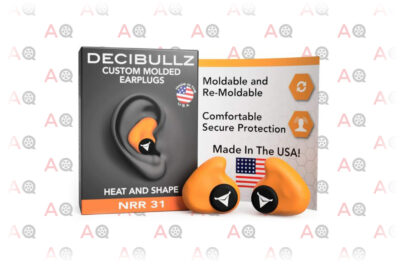
Editor’s Rating:
Quick Facts:
- Noise Reduction Rating: 31dB
- Molded fit, with tips of S, M, and L sizes and M foam alternative.
- Made from Thermoplastics.
- Comes with: Moldable earpieces, sound plug, four sets of tips, carry case.
When comfort is the priority, and no earplug seems to fit properly, you can rest easy knowing that Decibullz will have you covered. By following an easy guide (or linked-to video), you can mold the earpieces to fit the unique curves of your ear while using the same high-quality core. The custom-molded earplugs come with three differently sized tips plus a pair of foam tips for higher attenuation.
Not that you will need it. The standard core of the Decibullz has an NRR higher than anything short of the foam plugs, making them as good for shooters as for riders. This comes with the negative of it being slightly harder to hear conversations or music, but the filtering is better than we expected.
Obviously, these are not low-profile plugs, but that doesn’t mean they are ugly. In fact, they come in a range of colors. The Decibullz custom-molded Earplugs would be the ideal choice for child riders and those who find earplugs synonymous with discomfort.
Pros
- Custom molding to your ear.
- Tips come in multiple sizes.
- One of the highest NRR ratings out there.
Cons
- May take multiple attempts to mold correctly.
- May block out more noise than you want.
8. Least Visible Motorcycle Earplugs: ClearPlugs High Fidelity Invisible Ear Plugs

Editor’s Rating:
Quick Facts:
- Noise Reduction Rating: Unknown (25 SNR).
- Small and large size.
- Made from Silicone.
- Comes with: Earplugs in two sizes, aluminum case.
In perhaps the most impressive physical design, the ClearPlugs High Fidelity Invisible Ear Plugs are both extremely low-profile and easy to remove. Because they come in both small and large sizes, they are also more likely to fit than many other low-profile choices.
The ClearPlugs offer good sound dampening while not removing the ability to hear conversations and can handle louder noises easily. They come in an aluminum case, though it isn’t anywhere near as well-designed as the plugs themselves, which are often prone to breaking.
It is a disappointment that these plugs are made from silicone, which makes them a little easier to get dirty and slip out of ears. With the two sizes and great design, however, this is not as big an issue as it could be.
For low profile plugs without any frills, the middle-of-the-road ClearPlugs look good, do a great job, and don’t cost a fortune.
Pros
- Extremely low profile.
- Clear ability to hear conversations and music.
- Surprisingly easy to remove.
Cons
- Silicone material.
- The aluminum case is flimsy and prone to breaking.
9. Most Customisable Motorcycle Earplugs: EarPeace Motorcycle Ear Plugs
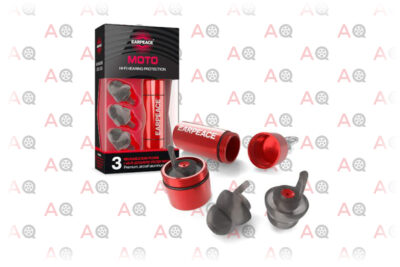
Editor’s Rating:
Quick Facts:
- Noise Reduction Rating: 11-19.
- Small and large size.
- Made from Silicone.
- Comes with: Earplugs in two sizes, aluminum case.
While many of the great earplugs in this list offer different sized tips, only the EarPeace Motorcycle Ear Plugs offer different cores. This means you can choose a different filter for city driving than you would be cruising at faster speeds out in the great beyond. Just keep the spares in the aluminum case that holds multiple sets for just this purpose.
These plugs are low-profile but can be a little difficult to remove. While comfortable at first, long rides will come with some discomfort due to the silicone manufacturing.
If you are a rider that finds themselves in constantly changing settings, the EarPeace earplugs will be cheaper than buying three different sets of other plugs.
Pros
- Multiple cores, suiting different roads.
- Comes in different tip sizes.
- The aluminum case holds multiple sets.
Cons
- Silicone material makes it less comfortable in the long term.
- Sometimes difficult to remove.
10. Best Disposable Motorcycle Earplugs: Mpow Super Soft Sleeping Earplugs
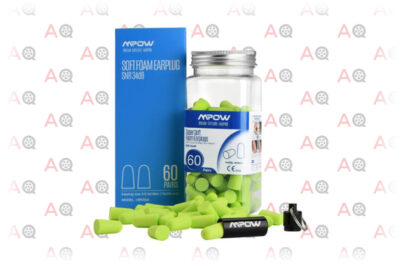
Editor’s Rating:
Quick Facts:
- Noise Reduction Rating: 32dB
- One size fits all.
- Made from Polyurethane foam.
- Comes with: 60 Earplugs, an aluminum case that holds one pair.
When you’ve spent all your money on the bike itself and aren’t interested in making conversation at the gas pump, then you can skip all the fancy features and just concentrate on protecting your hearing. In this case, you don’t need to look further than standard foam earplugs.
Mpow offers the best bang for the buck, with 60 foam earplugs at a budget price. With each plug being good for about three rides, you are looking at less than ten cents a ride.
The noise dampening is indiscriminate and there is nothing low-profile about having a couple of Cheetos in your ears, but they do the job better than anything else and this is what matters. It’s a bonus that they are quite comfortable, even for long periods.
Not the greatest choice for the environment, and more of a “sound blocker” than a “sound filter,” but by being cheap, effective, and no-frills, you don’t need to look any further than Mpow Super Soft earplugs.
Pros
- Inexpensive and blocks out the most noise.
- Comfortable to wear for long periods.
- One pair can last multiple uses.
Cons
- Indiscriminate with noise reduction.
- High profile.
- Environmentally unfriendly as disposable products.
Guide to Buying the Best Motorcycle Earplugs for 2025
Your health is not something to mess with and, with permanent hearing loss being a guarantee for anyone who spends time riding at high speed, it is vital to invest in a good pair of earplugs.
To know what makes a pair of earplugs effective, it is important to have a basic understanding of how hearing works, what we can do to protect it, and how we can do so without giving up comfort or dollars.
A Crash Course in Sound and Hearing
While doctors can spend a decade in training to get a full understanding of how our ears work and how sound affects them, there are only a few things we need to understand to make the right choices.
Having a basic understanding of how the ear works and what loud noises can do helps us better appreciate how bad it is when things go wrong. By understanding concepts like Threshold Shift and Noise Reduction Rating, we can make informed decisions about our ears.
The Anatomy and Physiology of the Ear

The human ear is made of three parts:
- The outer ear – The fleshy bits we see, which help direct sounds from the outside world into our ear canal. These sounds then hit the tympanic membrane (like the skin of a drum, which is why we often call it the eardrum).
- The middle ear – The tympanic membrane vibrates the bones of the middle ear, like a drum kit in reverse. These are the smallest bones in the human body.
- The inner ear – The vibrations of the bones then move into the inner ear, a round tube of liquid and hairs, called the Cochlea. It is the hairs in the Cochlea, shaking from the vibrations, that turn sound into electricity, sent by nerves into the brain. It is these same hairs that can be overcome by vibrations too powerful, damaged and killed by sounds that are too loud.
For more information about how sounds turn from vibrations in the air to ideas in our heads, check out this interesting video from the National Institute of Health.
How Much Sound Can We Handle?
The “loudness” of sounds is measured in decibels (dB), which is a “logarithmic scale.” This means that a 90dB sound is ten times louder than a sound that is 80dB. This is important to consider when we learn that experiencing 110dB for only two minutes can do permanent damage to your hearing.
How Much Sound Does Riding a Motorcycle Make?
It might come as a surprise to learn that the sound of a motorcycle itself isn’t that big a deal when it comes to our hearing. The louder Harley Davidsons make about 60-80dB of sound, while most of us ride bikes that make sounds less than ten percent the loudness of a standard car.
The problem with sound for us riders is “Wind Sound,” the noise and pressure that rushes past our face, even despite windshields and the best motorcycle helmets.
The University of Southampton has worked out that you only need to be riding at 40mph to reach 85dB and once you reach 70mph, you are experiencing noises over 106dB. At this point, you can experience permanent hearing loss in only three minutes.
What Causes Hearing Loss?
Hearing loss is caused in two different ways. First, the higher-decibels cause damage to the fine hairs inside our inner ear, permanently damaging them. Secondly, a phenomenon called “Threshold Shift” occurs, in which our brain tries to adapt to the louder sounds.
When we no longer experience these, the brain is unable to return to prior functioning. While this is sometimes temporary, it is often not. The louder the noise, the more likely the shift is to become permanent.
Hearing loss is also accumulative. When you lose some ability, it will never come back. And the next three minutes will cause just as much damage as the last (except, because you have less remaining, it will cause a larger percentage of damage).
Some people think helmets, because they protect our face from the wind, must also protect our ears from wind noise. The reality is that helmets may be making things worse.
How Do Earplugs Work?
Earplugs are designed to remove the louder “Wind Sound” alone, leaving the other sounds of the road (sirens, horns, etc.) intact, as well as not affecting our hearing when standing still. Think of it as a glass of beer, earplugs just taking off the head that is spilling over the sides, leaving only the good stuff behind.
What Is the Noise Reduction Rating?
The Noise Reduction Rating is a standard used by the US Environmental Protection Agency to measure the dangers of noise on hearing. It isn’t directly linked to decibels – a rating of 15 does not mean earplugs block exactly 15dB of sound – but it does help indicate how useful hearing protection is.
Internationally, the European Union uses the Single Number Rating (or SNR), which uses different calculations again.
It is fair to say that the greater the NRR, the better your earplugs are at blocking noise. But blocking noise below 80dB is neither necessary nor useful, as you may not be as aware of your surroundings. We recommend using earplugs that have a rating of 10-20 for normal usage and about 15-30 for high-speed riding.
The Secret Additional Benefit of Reducing Wind Noise
While decreasing wind noise below the safe decibel level prevents hearing loss, earplugs offer another benefit that isn’t talked about as often as it should be: decreased fatigue.
Removing the frequencies of wind noise, regardless of how many decibels of noise drop, removes a constant sound that is tiring for many riders. It is easy to become distracted when tired, and fatigue is a major factor in rider-caused motorcycle accidents. Earplugs, at any speed, decrease the risks associated with fatigue.
Common Motorcycle Earplug Materials
Modern earplugs can be made from a range of materials, from plastic foam to silicone and even patented thermoplastics. Each come with their own benefits and drawbacks, so it is important to think about the material used to make the earplugs you are looking at.
Foam
When we say foam, we aren’t talking about shaving cream. Most foam earplugs are generally made from polyvinyl chloride or PVC. PVC is a major source of phthalates, which are harmful to child health and bad for the environment.
On the other hand, quality foam products like the Mpow earplugs are made from Polyurethane, which doesn’t suffer the same problems.
Foam plugs dampen sound dramatically, and rarely have an NRR under 30. However, they are “indiscriminate” with their blocking, decreasing all sound. This means they are highly effective, but not useful if you want to hold a conversation or listen to music. They also run the risk of making it difficult to hear emergency sirens.
Foam plugs are designed as “one size fits all” and are squeezed into shape. They usually stick out quite a bit from our ears and do not do well past a few uses.
Silicone
Silicone rubber is a strong plastic that is non-toxic, firm, and waterproof, which makes it great for seals. It is also antimicrobial and is used for implants. However, being so firm, it does not mold very well once it has set and can become sticky and dirty quite easily. A silicone earplug is great when it fits well and terrible when it doesn’t.
Thermoplastics
Thermoplastics are a mix of a range of different polymers and are often specially made for companies. Alpine earplugs use a patented AlpineThermoShape plastic that only exists in their brand.
Thermoplastics are easier to mold and can therefore produce better seals with larger or smaller ear canals. They can also be far more comfortable than the harder silicone plugs. However, Thermoplastics are expensive materials and do not have the same lifespan as silicone.
What About Music?
While it is important to note that some jurisdictions make listening to music illegal while you ride, many others allow this freedom. Listening to some cruising tunes as you ride is an enjoyable experience and choosing the right plugs can play an important role in keeping those songs coming.
While there are good hybrid plugs/earbuds like Plugfones out there, the best earplugs don’t filter out music from Bluetooth speakers and can be just as effective.
The Problem With Noise Cancelling Technology
There is nothing inherently wrong with noise-canceling devices. In fact, by encouraging users to turn down their headphones, noise-canceling devices decrease hearing loss caused by having your music up too loud. The noise of conversation is no longer a distraction, so you don’t feel the need to turn up the headphones.
What they do not do, however, is dampen the sound that already exists. Modern noise-canceling headphones and earbuds use frequencies that “cancel” sounds from outside by creating a “balancing noise.” The noise still exists, and still enters our ears, we just don’t register it. At high decibels, this means that our ears are still experiencing damage, and exposure will still cause hearing loss.
To use noise-canceling earbuds to combat wind noise would be to simply add yet another source of 100dB noise. You wouldn’t hear the wind anymore, but it would be doing as much, or maybe even more, damage to your hearing.
Earplugs and the Law
It is a terrible truth that, in some parts of the United States, wearing earplugs is against the law. Fortunately, each day brings good news as more states realize the importance.
Some states do not allow music, while others allow it only in one ear. It is important to look up the law in your specific jurisdiction to ensure that you are doing the right thing. As of 2023, no jurisdiction directly insists on the wearing of earplugs.
Final Thoughts
It is a sad thing to learn that over one-quarter of riders deliberately avoid using ear protection, and less than half use it regularly. Some of this has to come down to believing that the only ear protection available will cut all noises and involves wearing bulky, uncomfortable plugs that sit awkwardly under your helmet.
By providing a guide to the best motorcycle earplugs out there, we hope to change these numbers while helping everyone make the best decision for their health and safety.



